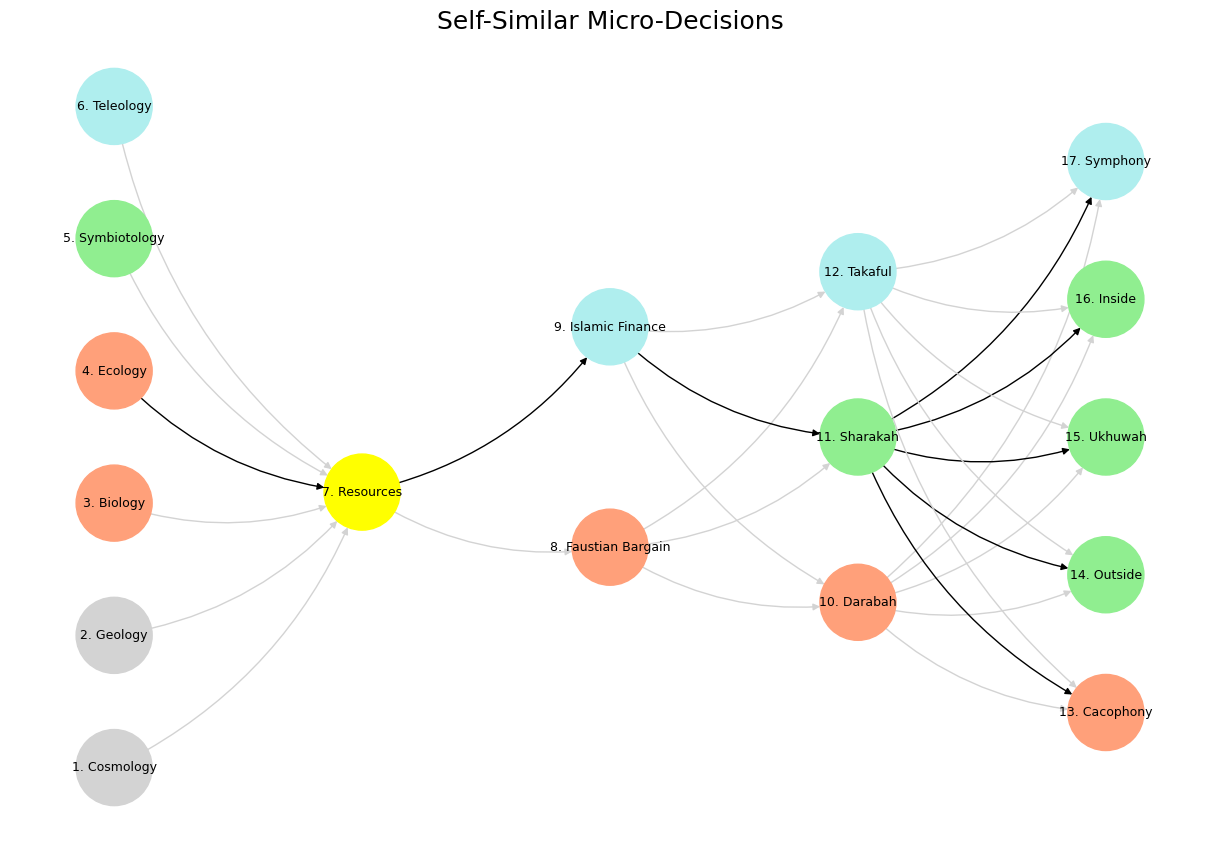Resilience 🗡️❤️💰#
+ Expand
- What makes for a suitable problem for AI (Demis Hassabis, Nobel Lecture)?
- Space: Massive combinatorial search space
- Function: Clear objective function (metric) to optimize against
- Time: Either lots of data and/or an accurate and efficient simulator
- Guess what else fits the bill (Yours truly, amateur philosopher)?
- Space
- Intestines/villi
- Lungs/bronchioles
- Capillary trees
- Network of lymphatics
- Dendrites in neurons
- Tree branches
- Function
- Energy
- Aerobic respiration
- Delivery to "last mile" (minimize distance)
- Response time (minimize)
- Information
- Exposure to sunlight for photosynthesis
- Time
- Nourishment
- Gaseous exchange
- Oxygen & Nutrients (Carbon dioxide & "Waste")
- Surveillance for antigens
- Coherence of functions
- Water and nutrients from soil
At the core of all processes—biological, economic, ideological—is a fundamental reality, an unprocessed substrate we may call Truth. This is the raw material of existence, vast, chaotic, and indiscriminate. The human mind, like all systems in nature, cannot take in this truth in its entirety. It must be refined, sieved through structures that sort, eliminate, and shape it. This Filter, whether biological, mechanical, or ideological, serves as both a necessity and a limitation, channeling only select elements forward. The final product, the Illusion, is a structured output, appearing to stand independently but utterly dependent on the filtering mechanisms beneath it.
Personalized Medicine, National Identity, and Trump. With Trevor Noah and Company.
In biology, we observe this process vividly in trees. A tree does not take in everything from the soil; it absorbs only what it needs—water (\(H_2O\)), nitrates (\(NO_3^-\)), phosphates (\(PO_4^{3-}\)), potassium (\(K^+\)), and trace minerals. The roots serve as the primary filter, a mechanism that sifts through an abundant but chaotic environment, extracting only those elements that contribute to the tree’s function. Similarly, in the realm of thought, we do not absorb the entire truth of the universe, but rather fragments, shaped by sensory limitations, cognitive biases, and social structures.
Once these elements are drawn in, they must be distributed. The trunk acts as a secondary filter, ensuring only the necessary nutrients reach their destinations. This mirrors the function of ideological, economic, or social institutions, which determine how knowledge, power, or resources flow. In a capitalist system, for instance, capital and labor are filtered upward, disproportionately accumulating in select branches, whereas in a sustainable system, distribution remains proportionate, ensuring systemic equilibrium.
Show code cell source
import numpy as np
import matplotlib.pyplot as plt
import networkx as nx
# Define the neural network layers
def define_layers():
return {
'Tragedy (Pattern Recognition)': ['Cosmology', 'Geology', 'Biology', 'Ecology', "Symbiotology", 'Teleology'],
'History (Resources)': ['Resources'],
'Epic (Negotiated Identity)': ['Faustian Bargain', 'Islamic Finance'],
'Drama (Self vs. Non-Self)': ['Darabah', 'Sharakah', 'Takaful'],
"Comedy (Resolution)": ['Cacophony', 'Outside', 'Ukhuwah', 'Inside', 'Symphony']
}
# Assign colors to nodes
def assign_colors():
color_map = {
'yellow': ['Resources'],
'paleturquoise': ['Teleology', 'Islamic Finance', 'Takaful', 'Symphony'],
'lightgreen': ["Symbiotology", 'Sharakah', 'Outside', 'Inside', 'Ukhuwah'],
'lightsalmon': ['Biology', 'Ecology', 'Faustian Bargain', 'Darabah', 'Cacophony'],
}
return {node: color for color, nodes in color_map.items() for node in nodes}
# Define edges
def define_edges():
return [
('Cosmology', 'Resources'),
('Geology', 'Resources'),
('Biology', 'Resources'),
('Ecology', 'Resources'),
("Symbiotology", 'Resources'),
('Teleology', 'Resources'),
('Resources', 'Faustian Bargain'),
('Resources', 'Islamic Finance'),
('Faustian Bargain', 'Darabah'),
('Faustian Bargain', 'Sharakah'),
('Faustian Bargain', 'Takaful'),
('Islamic Finance', 'Darabah'),
('Islamic Finance', 'Sharakah'),
('Islamic Finance', 'Takaful'),
('Darabah', 'Cacophony'),
('Darabah', 'Outside'),
('Darabah', 'Ukhuwah'),
('Darabah', 'Inside'),
('Darabah', 'Symphony'),
('Sharakah', 'Cacophony'),
('Sharakah', 'Outside'),
('Sharakah', 'Ukhuwah'),
('Sharakah', 'Inside'),
('Sharakah', 'Symphony'),
('Takaful', 'Cacophony'),
('Takaful', 'Outside'),
('Takaful', 'Ukhuwah'),
('Takaful', 'Inside'),
('Takaful', 'Symphony')
]
# Define black edges (1 → 7 → 9 → 11 → [13-17])
black_edges = [
(4, 7), (7, 9), (9, 11), (11, 13), (11, 14), (11, 15), (11, 16), (11, 17)
]
# Calculate node positions
def calculate_positions(layer, x_offset):
y_positions = np.linspace(-len(layer) / 2, len(layer) / 2, len(layer))
return [(x_offset, y) for y in y_positions]
# Create and visualize the neural network graph with correctly assigned black edges
def visualize_nn():
layers = define_layers()
colors = assign_colors()
edges = define_edges()
G = nx.DiGraph()
pos = {}
node_colors = []
# Create mapping from original node names to numbered labels
mapping = {}
counter = 1
for layer in layers.values():
for node in layer:
mapping[node] = f"{counter}. {node}"
counter += 1
# Add nodes with new numbered labels and assign positions
for i, (layer_name, nodes) in enumerate(layers.items()):
positions = calculate_positions(nodes, x_offset=i * 2)
for node, position in zip(nodes, positions):
new_node = mapping[node]
G.add_node(new_node, layer=layer_name)
pos[new_node] = position
node_colors.append(colors.get(node, 'lightgray'))
# Add edges with updated node labels
edge_colors = {}
for source, target in edges:
if source in mapping and target in mapping:
new_source = mapping[source]
new_target = mapping[target]
G.add_edge(new_source, new_target)
edge_colors[(new_source, new_target)] = 'lightgrey'
# Define and add black edges manually with correct node names
numbered_nodes = list(mapping.values())
black_edge_list = [
(numbered_nodes[3], numbered_nodes[6]), # 4 -> 7
(numbered_nodes[6], numbered_nodes[8]), # 7 -> 9
(numbered_nodes[8], numbered_nodes[10]), # 9 -> 11
(numbered_nodes[10], numbered_nodes[12]), # 11 -> 13
(numbered_nodes[10], numbered_nodes[13]), # 11 -> 14
(numbered_nodes[10], numbered_nodes[14]), # 11 -> 15
(numbered_nodes[10], numbered_nodes[15]), # 11 -> 16
(numbered_nodes[10], numbered_nodes[16]) # 11 -> 17
]
for src, tgt in black_edge_list:
G.add_edge(src, tgt)
edge_colors[(src, tgt)] = 'black'
# Draw the graph
plt.figure(figsize=(12, 8))
nx.draw(
G, pos, with_labels=True, node_color=node_colors,
edge_color=[edge_colors.get(edge, 'lightgrey') for edge in G.edges],
node_size=3000, font_size=9, connectionstyle="arc3,rad=0.2"
)
plt.title("Self-Similar Micro-Decisions", fontsize=18)
plt.show()
# Run the visualization
visualize_nn()

Fig. 6 History is a fractal unfolding of entropy and order.#
At the level of the canopy, the illusion manifests. Here, the final synthesis occurs—photosynthesis, where carbon dioxide (\(CO_2\)), water, and sunlight merge to create glucose (\(C_6H_{12}O_6\)) and oxygen (\(O_2\)). This is the last mile of transformation, where unfiltered, raw reality—soil, air, and light—becomes the visible structure of the tree, its leaves, its energy, its very being. The illusion is not deception but the culmination of hidden processes. A leaf appears autonomous, a brilliant green tapestry catching the sun, but it is only the endpoint of a vast subterranean network of unseen filtration.
This same pattern can be seen in human perception. Our minds construct coherent images of reality, but these are merely processed versions of something far more complex. In media, raw information is absorbed, filtered through editorial biases, political pressures, and algorithmic curation before emerging as a seemingly whole, self-contained narrative. The public consumes the illusion of reality, rarely questioning the filters beneath. The economic system follows the same trajectory: raw materials and labor are filtered through corporate structures, supply chains, and financial instruments before emerging as the final product—a sleek object, a brand, a stock price—divorced from its hidden origins.
But what happens when the filter is corrupted? When nutrients are misallocated in a tree, chlorosis sets in—the leaves yellow, photosynthesis falters, and the tree begins to wither. The same occurs in economic and social systems when filters—governments, media, financial institutions—become distorted, hoarding wealth, suppressing dissent, or feeding falsehoods. The illusion then becomes unstable, unable to sustain itself. Like a leaf deprived of sunlight or a market deprived of real productivity, collapse becomes inevitable.
The key to understanding and, perhaps, reclaiming agency lies in recognizing the filter. Just as a botanist traces nutrient pathways, just as a chemist deconstructs a reaction, so too must we dissect the systems that shape our perception and resources. To see the filter is to gain control over the illusion. It allows us to question not just the final product—be it a leaf, a news story, or a stock valuation—but the hidden processes that create it.
History is a fractal unfolding of entropy and order, a ceaseless churn where civilizations rise on the back of extracted resources and collapse under the weight of their own complexity. The notion that progress is linear is an illusion; the arrow of time merely inscribes the same motifs at different scales. To observe history is to witness the second law of thermodynamics in slow motion—an empire, a city, a culture, each structured around an energetic peak before unraveling into diffusion. Yet entropy does not mean chaos; it is the necessary precondition for renewal.
— Yours Truly
Nature has perfected this process over millennia. A tree’s filtering system is resilient and adaptive, capable of adjusting to environmental shifts. Yet human systems, unlike trees, often suffer from rigidity, resisting adaptation until crisis forces transformation. The lesson here is that healthy illusions depend on honest filters, and honest filters depend on a willingness to acknowledge truth, however inconvenient it may be.
To seek unfiltered truth is folly—it is beyond the capacity of any system, be it biological or cognitive. But to recognize filtration as a necessary but manipulable process? That is wisdom. It is the difference between being a passive recipient of illusion and an active participant in shaping reality.

